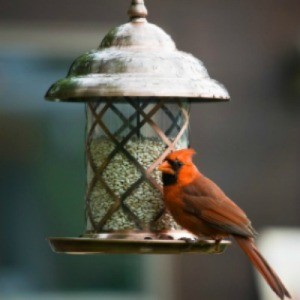 If you enjoying feeding backyard birds, cleaning and maintaining your birdfeeders is an important part of keeping your feathered friends safe and healthy. Wild birds prefer fresh, mold-free birdseed and a safe and convenient place to feed. Clean and well-maintained feeders not only attract more birds, they also reduce the risk of disease.
If you enjoying feeding backyard birds, cleaning and maintaining your birdfeeders is an important part of keeping your feathered friends safe and healthy. Wild birds prefer fresh, mold-free birdseed and a safe and convenient place to feed. Clean and well-maintained feeders not only attract more birds, they also reduce the risk of disease.
It's common for wooden feeders to weather and fade over the years. It is not necessary to treat wood feeders with products; however, if you wish to maintain the appearance of your feeder, you can follow these simple directions.
As with all wooden feeders, inspect them for protruding nails and sharp points or edges each time you fill them with seed. Small cuts and scratches on feet and toes can quickly lead to infections.
Copper is highly resistant to corrosion, and if not preserved, acquires a beautiful green patina over time. Copper cleaners are considered toxic to birds, so if you want to restore the copper to its original luster, try one of these non-toxic recipes:
Cleaning your bird feeders regularly year round is important for the health of the birds. All you really need is a pair of rubber gloves, hot water, scent-free liquid dish soap, a scrub brush, and some white distilled vinegar. Fill a sink or tub with hot soapy water and let the feeder soak in it for 10 or 15 minutes to loosen up any caked-on debris. After soaking, give the feeder a good scrubbing, then rinse well and let it air dry. For tough jobs, refill with clean water and 4 cups of vinegar. Let the feeder soak for 1 hour. Rinse thoroughly and let it air dry.
At least once a month soak the feeder in full-strength white distilled vinegar and clean with a bottle brush. Rinse well with warm running water. Evidence suggests that using bleach to clean plastics containing polycarbonates (like those found in some feeders) can accelerate the leeching of bisphenol A (BPAs). It's not yet known if this is harmful to birds, but it's better to be safe than sorry and avoid using bleach.
Keeping the area under your feeders clean and free from debris is an ongoing chore. Use a broom or shovel to transfer fallen seeds and droppings to your compost pile and cover them with a layer of mulch. If your compost pile is "cold", you may eventually see some seeds germinate. Simply turn them under.
Here are the questions asked by community members. Read on to see the answers provided by the ThriftyFun community.
I'd like to know how to clean out wooden bird feeders. What products to use or not use, and any tips to keep them looking nice. They all have openings so I can get in the corners.
I use a natural dishsoap (sun and earth etc) and water and scrub them. Rinse well and let dry naturally in the sun before refilling.